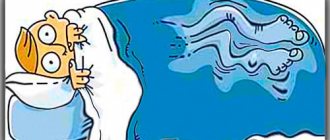It's hard to believe that there are people who seriously consider themselves either an eighteen-year-old striptease dancer or a professor of philosophy. However, this happens. In such cases, spiritualists are sure that someone’s spirit has taken possession of the person.
Church ministers, in general, take a similar point of view and talk about possession. Doctors call this a split personality, or more precisely, “dissociative identity disorder” and believe that this illness occurs under the influence of serious stress. About two hundred such cases have been officially recorded, although it is believed that there are many more. It’s just that patients manage to lead a double life so cleverly that no one around them assumes that they are dealing with a psychopath. But those cases that are known to medicine formed the basis of many books and films. Because split personality is strange, scary and, in a way, cool!
What it is?
Dissociative identity disorder (multiple personality syndrome) is the general name for a patient’s condition in which, in addition to the main personality, at least one more person coexists at the same time. This second one is called subpersonality. She is capable of taking away the right to control a person’s entire body, his feelings, mind, and will from the main (dominant) personality, which is given to a person from birth.
Some psychiatrists are confident that dissociative identity disorder arose under the influence of many fantastic stories, as a result of watching unscientific programs, and using unscientific terms and facts. Other experts are confident that people suffering from multiple personality syndrome really exist. And proof of this is the works of doctors who describe such disorders long before the advent of psychiatry as a science (around the end of the 18th century).
Treatment of dissociative identity disorder
The optimal tactics for managing patients is a combination of measures:
- relieving symptoms of the disease;
- improving the general well-being of the patient;
- aimed at ensuring human security;
- aimed at restoring the integrity of the integrated elements of the psyche;
- consolidating the achieved single identity.
To date, there are no pharmaceutical drugs that can overcome and eradicate the disease itself. Pharmacological treatment does not show the desired results in the treatment of dissociative disorder and is focused exclusively on eliminating individual symptoms. To overcome concomitant depressive symptoms, they often resort to the prescription of some modern antidepressants.
As a rule, the treatment program for dissociative disorder is represented by methods of psychotherapy: cognitive, family, insight-oriented and clinical hypnosis techniques.
SUBSCRIBE TO THE VKontakte GROUP dedicated to anxiety disorders: phobias, fears, obsessive thoughts, VSD, neurosis.
Does this syndrome really exist?
It is often quite difficult to recognize that one person has several personalities at once. And the patient himself can often claim that his personalities know nothing about each other, they have completely different opinions, their behavior patterns are completely different. But there is no doubt that multiple personality syndrome really exists. Today, experts treat this phenomenon with minimal skepticism and do not try to immediately reject it, but try to explain and characterize it from a scientific point of view.
Doris Fisher
PHOTO:
When doctors talked about Doris Fisher, they meant her five personalities. Real Doris, Lethargic Doris, Sickly Doris, Margarita and Sleeping Margarita. In general, a kind of kinder surprise or even a nesting doll. Margarita was considered the coolest “matryoshka”. She constantly did nasty things, but blamed it on the Real Doris. It was Margarita who tore pages out of books, stained her clothes with mud and could deliberately cut herself with a knife. But only the Real Doris felt guilt, resentment and pain. Psychiatrists tried for a long time to cure the poor thing, but nothing worked. Medicines, therapy, hypnosis - all in vain. Then the doctors decided to take one last chance and invited... a medium. After his visit, all the “extra people” disappeared, and only Doris the Real remained alive. After this, trust in official medicine.
How to distinguish multiple personality syndrome from schizophrenia
The concepts of schizophrenia and multiple personality syndrome should not be confused, since these are completely different phenomena in psychiatry. Thus, people suffering from schizophrenia do not have multiple personalities. Their illness is characterized by the fact that, under the influence of chronic psychosis, they suffer from hallucinations that make them see or hear things that are not really happening. The main symptom of schizophrenia is the presence of a so-called delusional idea in the patient. Approximately 50% of patients hear voices that do not exist in reality.
Multiple personality disorder and schizophrenia have one thing in common: people suffering from these diseases are more likely to commit suicide than patients with other mental disorders.
Treatment
Therapy includes two areas:
- psychotherapeutic;
- medicinal.
In the first case, a treatment program is developed using hypnotic and relaxation techniques, psychoanalytic methods or symbol drama. These methods are based on identifying underlying problems and working to get rid of fears about them.
In the second, according to the doctor’s indications, patients are prescribed antipsychotics, antidepressants, tranquilizers, and sedatives. Some patients benefit from electroconvulsive therapy and artificial sleep.
Treatment of the disease is long and sometimes lifetime, but only by knowing what to do if you have a split personality, and by promptly contacting a qualified specialist, can you overcome this illness.
Description of the disease by the patients themselves
Patients suffering from multiple personality disorder may describe their condition as follows:
- The concept of depersonalization is when the patient says that he is “outside his body.”
- Derealization, when the patient describes the world around him as unreal for him, as if he is looking at everything that is happening through a distance or a veil of fog.
- Amnesia. The patient makes every effort, but cannot remember important personal information about himself. Often he forgets even those words that were spoken a few minutes ago.
- Confusion in awareness of one's own identity. A person suffering from multiple personality syndrome is in a state of complete disorientation. He cannot clearly answer the question of who he considers or imagines himself to be. Often he catches himself thinking that he hates his personality at the moment, when she is engaged in some type of activity (violates traffic rules, drinks alcohol).
- There is no clear understanding of where a person is, what time it is now, what situation he is in.
A person with multiple personality disorder has one host personality that can provide basic real information about him. Other dissociative states (other personalities) are not mature, they can only talk about individual episodes and sensations from life, their memories are scarce and one-sided. It so happens that the host personality often does not even suspect the presence of other personalities.
What does a person with split personality feel like?
Living with one or more “passengers” is difficult, especially if such a person has not been diagnosed. In particular, you may encounter the following problems:
- Depersonalization . This is the feeling when your own actions are perceived as if from the outside.
- Derealization . This is the feeling that the world around us and what is happening around us is unreal.
- Amnesia . This is the inability to remember significant personal information that is so extensive that it cannot be attributed to simple forgetfulness. Microamnesia may also exist, where the discussion being discussed is not remembered.
- Identity confusion or identity change . They both involve confusion about who a person is. Example: a person has problems determining what interests him in life, what his political, religious or social views are.
In addition to this, the patient may experience problems with the sense of time and place.
Multiple Personality Syndrome: Causes
Among all the reasons that can become the impetus for the formation of dissociative identity syndrome in childhood, there is one main one - violence. It can be both emotional and physical. In any case, violence causes irreparable harm to the child’s psyche. The next reason is the incorrect upbringing of parents, when the child experiences severe fear around them or severe psychological discomfort.
Recently, drug addiction and alcoholism have become the cause of a person’s mental health crisis, provoking the emergence of a dissociative personality.
What kind of disease is this?
Split personality is a special mental state in which a person feels himself to be several entities.
The scientific name of the disease is dissociative identity disorder , which is part of a group of mental phenomena with the isolation of certain functions of consciousness from an integrated (general) idea of oneself and the world.
These separate personalities exist autonomously from each other and may never intersect in a person's thoughts and actions. That is, in the subconscious all the “characters” are adjacent, but in the consciousness they “appear” one by one.
The mechanism of development of this process has not been sufficiently studied; it is assumed that split personality is formed under the influence of a number of factors:
- hereditary predisposition;
- mental trauma;
- style of upbringing in the family - hypoprotection;
- emotional disorders;
- fears and anxieties;
- harsh system of punishments in childhood;
- physical and (or) psychological violence;
- excessive danger, kidnapping;
- “collisions” with death in accidents, during surgical operations, during traumatic injuries, during the “departure” of loved ones;
- virtual addictions to books, films, computer games;
- long stay without sleep and rest;
- chronic stress;
- poisoning with toxic substances;
- drug addiction, alcoholism;
- severe infections and diseases of the body;
- heightened sense of guilt, protracted internal conflicts, complexes, shyness.
In the 90s, American scientists, while studying dissociative disorders, discovered their connection with facts of violence in the biographies of patients (in 98% of cases out of 100, of which 85% were officially confirmed).
Signs (symptoms) of the disorder
How does multiple personality syndrome manifest itself? Signs of the disorder are as follows:
- Amnesia, when the patient cannot tell basic information about himself as an individual.
- The presence of two or more subpersonalities, each of which has its own model of behavior, character, habits, gestures, race, gender, conversation, accent, etc. A subpersonality can even be an animal.
- Switching from one personality to another. This process takes from a few minutes to several days.
- Depression.
- Sudden mood swings.
- Suicidal tendencies.
- Sleep disorders (both insomnia and nightmares).
- Feelings of anxiety on the verge of panic or phobias.
- Often drug or alcohol use.
- Rituals and compulsions.
- Hallucinations (both visual and auditory).
- Eating disorders.
- Severe headaches.
- A state of trance.
- Self-persecution and tendency to violence, including towards oneself.
Many patients say that, being under the guidance of one person or another, they cannot control either their body or their actions. In essence, they are third-party observers of everything that their personality does with their body and the world around them. They are often ashamed of such actions; they admit that their master personality would never do such a thing and would not even dare.
Diagnostics
To confirm the diagnosis, use the following points.
- Conviction of persistent dissociation.
- The manifestation of at least two different entities of one person, which have their own characters, behavior and worldview.
- Exclusion of organic brain damage by:
- electroencephalography;
- Ultrasound;
- X-ray examination;
- CT scan;
- MRI.
To confirm the diagnosis, special tests may also be performed to determine:
- memory problems;
- change in self-awareness;
- deterioration of relationships with close circles;
- disturbance of emotionality;
- mood swings;
- experiences of violence;
- excessive responsibility, personal or professional.
Multiple Personality Syndrome: Examples
According to the most conservative estimates, the world today knows about 40 thousand patients suffering from multiple personality syndrome. The most famous, both in psychiatry and in general society, are the case histories of such people as Louis Vive (one of the first officially recorded cases of dissociative personality), Judy Castelli, Robert Oxnam, Kim Noble, Truddy Chase, Shirley Mason, Chris Costner Sizemore, Billy Milligan, Juanita Maxwell. Most of these patients suffered from severe violence in childhood, which caused them to develop dissociative identity disorder.
Shirley Mason
PHOTO:
For a long time, the American Shirley Mason existed not on her own, but in as many as four forms. All of Shirley's personalities were independent and completely different from each other. They differed in intelligence, age and character. The most aggressive and harmful person was the one who called herself Sally. During hypnosis sessions, Sally was capricious, refused to obey, and acted out. Only flattery and persuasion managed to convince Sally to leave her mistress’s body and leave the others alone. Left without Sally, Shirley Mason's three personalities quickly calmed down and united into a single whole.
Billy Milligan
Billy Milligan is a person with multiple personality disorder. He became known to the general public thanks to an absolutely incredible court decision against him. Thus, in the United States, a court found him not guilty of committing several serious crimes due to his multiple personality syndrome. Billy Milligan underwent a thorough psychiatric examination, the results of which not only did not constitute a medical secret, but were even published in newspapers, magazines, and were featured on television programs. At the trial, 4 psychiatrists confirmed the diagnosis of dissociative personality under oath.
Billy received mental health treatment on several occasions. Billy Milligan's Multiple Personality Syndrome has been widely discussed. Society is still divided into two camps and argues over who Milligan really was: a skilled swindler who managed to deceive a large number of psychiatrists, scientists, judges, juries and police officers, or whether he really suffered from those living in him 24 personalities and did not belong to himself.
Split Personality - Interesting Facts
Multiple personalities living in one person are a unique phenomenon that has been of interest to specialists and ordinary people for many years. Here are some reliable facts about him:
- People with multiple personality disorder are mistakenly considered dangerous. They are more likely to harm themselves than others. Many admit that they tried to commit suicide on the “order” of one of their incarnations.
- Switching from one “I” to another usually occurs when a person feels threatened. “Trying on” another personality gives him self-confidence.
- In the process of treating illness, it is recommended to treat all individuals with equal respect.
- The most popular image of a person with a split personality is Dr. Jekyll and Mister Hyde.
- Between 1 and 3% of all people in the world suffer from dissociative disorder.
Billy Milligan's Multiple Personalities
The reason Billy Milligan developed multiple personality disorder was the violence and humiliation he experienced as a child. Psychiatrists counted as many as 24 personalities in him. Each of them had its own name and received a detailed description.
After being declared insane by the court, Milligan is sent for treatment to the Athens State Hospital psychiatric clinic. Thanks to highly qualified personnel, as a result of the work done, Billy Milligan was discovered to have 10 personalities, and after a while - 14 more.
The personalities of this person were of different ages, genders, nationalities, different in character, inclinations, habits, and behavior. Some of them spoke with an accent. So who got along with a person who was diagnosed with multiple personality disorder? Kevin, a 20-year-old guy who takes turns with Phil - both hooligans capable of crimes - takes turns leading Milligan; 14-year-old boy Denny, who was terrified of men; David, 8, who was responsible for storing pain; Adalana is a 19-year-old lesbian who is accused of committing one of the serious crimes; boy Sean - a deaf disabled person with disabilities and many others.
After 10 years of intensive treatment, Billy Milligan was released from a psychiatric clinic. The result of the treatment was the doctors’ conclusion, which stated that the patient fully identifies himself, which means that he got rid of all subpersonalities. After leaving the clinic, Milligan disappeared to communicate with the press and society; it is not known for certain whether the treatment had a real result, whether he got rid of all 24 personalities and whether they returned to him over time.
Kim Noble
PHOTO:
The first symptoms of the disease appeared in an Englishwoman at the age of 11. Now Kim is about sixty - and there are more than 20 personalities living in her. Patricia, who writes the book “All About Me,” dominates everyone. “About Me” is about the Kim who practically no longer exists. as individuals. But there is young and love-hungry Abby, kind housewife Bonnie, chaste Salome, eight-year-old Diabalus, and twenty-year-old Ken. Kim does not have the strength to suppress the various characters within herself; both doctors and family have come to terms with this. And friends on social networks.
Subscribe to our Facebook page
Manga
The problem of multiple personality syndrome has always interested not only psychiatrists, but also artists. Thus, a popular work whose main theme is multiple personality syndrome is the manga MPD Psycho. It represents Japanese comics. The history of their origin goes back at least one thousand years.
The manga MPD Psycho describes an amazing and interesting story from the mystical detective genre. It contains overtly cruel and bloody scenes, often straddling the border between madness and logic. The main character of the manga is a detective who works using intellectual methods to solve crimes. He suffers from multiple personality syndrome. He has to solve bloody crimes that are regularly committed. The main clue is the presence of a barcode under the killer's eye. But the detective himself has exactly the same mark. How can all these coincidences be connected?
Is there a split personality?
Multiple personality disorder goes by different names in medicine. Most people have a vague idea of this syndrome and do not believe in its existence; some consider it a consequence of drug addiction and confuse it with schizophrenia. This frightening pathology has interested people for hundreds of years. Even in Paleolithic cave paintings, where shamans “reincarnated” into animals or spirits, multiple personalities made themselves known. The phenomenon of double consciousness can also explain such concepts as:
- Incorporation of souls, otherworldly entities.
- Demon possession.
In past centuries, the above phenomena were fought with their own methods, sometimes cruel (even burning at the stake). With the development of medicine and psychology, the methodology has changed. In the 18th century, using the example of the story of the sick Victor Ras, who did not remember what he did during sleep - i.e. in an altered state of consciousness - split personality began to be considered as a syndrome that can be diagnosed and treated.
Scientific works that provide the most complete information about multiple personality syndrome
Dissociative identity syndrome has occupied a leading place in the works of many scientists for decades. One of the first descriptions dates back to 1791, when the Stuttgart doctor E. Gmelin described a German woman who, under the influence of the bloody events of the French Revolution, began to suffer from multiple personality syndrome. Her other “I” is a French woman who spoke perfect French.
A special place is occupied by books by Chinese specialists not only on the study of the syndrome, but also on methods of treating it.
In documents, until the mid-20th century, specialists officially registered and described in detail about 76 cases of dissociative personality.
Writers also paid close attention to the topic of multiple personality syndrome and dedicated their works to it. The general public was told about what multiple personality syndrome is in the books: “The Three Faces of Eve” and “Sybil.” The first was created by psychiatrists K. Thigpen and H. Cleckley in 1957. The book tells the story of their patient Eva White's dissociative personality. The second famous book, Sybil, was published in 1973. Her character also suffered from this disorder.
Today there are no preventive measures that could prevent the development of multiple personality syndrome. The main cause of the disease is psychological or physical abuse of children. All efforts should be devoted to preventing such situations. If violence does occur, then it is necessary to take action and also refer the child for help to a psychologist who will help him survive the severe stress of the trauma.
Chris Sizemore
PHOTO:
Her case is known thanks to the book “The Three Faces of Eve” and the movie of the same name. It is believed that Chris Sizemore fell ill due to mental trauma received in early childhood. When Chris, already in adulthood, became a patient of psychiatrists, it was discovered that three Eves lived in her - Eve White, Eve Black and Jane. All three personalities were completely independent, but they were persuaded to merge into one named Evelyn. Therapy is over. The patient seemed to be cured. But much later, in her autobiography, the woman admitted that in fact, not three, but as many as 22 subpersonalities lived in her. So it wasn’t just Evelyn who left the doctors, but a whole team of people who didn’t know each other. In the same autobiography, the patient wrote that in the end this entire harem calmed down and formed a kind of united Chris Sizemore. But who knows... Maybe some Polikarp Evgenievich has lurked there, who will emerge later.
Man is not omnipotent
Not only young people with an immature psyche can be susceptible to this phenomenon. Sometimes, for a person who is quite firmly on his feet, which applies to both his material and spiritual state, due to the prevailing circumstances it can be difficult to overcome the problems that suddenly befall him, especially if he is characterized by such a trait as maximalism.
For example, an outwardly attractive person with extraordinary abilities, who has always studied well, built a career, believes that he is able to overcome all difficulties in the world. And suddenly a force majeure circumstance falls upon him, of which there may be thousands, but the most terrible of which is the loss of loved ones. If at this time there is no one nearby who could support and console, then even a very strong person may not be able to cope with a sudden misfortune, fall into depression and, as a result, degrade.
Types of syndrome
Based on where the organic defect is located, the following types of dementia are distinguished:
- Cortical - characterized by damage to the cerebral cortex. This type is typical for Alzheimer's disease, Pick's disease, and alcoholic consequences.
- Subcortical - structures are affected that negatively affect neurological symptoms. This type of syndrome affects people with Parkinson's disease.
- Cortical-subcortical - caused by vascular disorders.
- Multifocal. This type is characterized by a large number of lesions throughout the nervous system.
Types of dementia are identified through a serious examination, as a result of which a diagnosis is made that affects the nature of treatment. Each type has its own reasons for its occurrence.
How to help?
Personality degradation can stop. First of all, you should take a critical look at yourself from the outside and adequately evaluate your actions. To escape from heavy thoughts, you need to spend as much time as possible with people, go to the cinema, to exhibitions, and read more books. You shouldn't be alone with yourself. Help people - good deeds add meaning, you will experience the pleasure of knowing that someone needs you. An active life position, a favorite job, a lot of hobbies - this is the guarantee that personality destruction will bypass. Don’t be shy about asking your loved ones for help; they will happily surround you with warmth and attention.
Other reasons contributing to personality disintegration
Alcoholism is far from the only reason why a person can lose himself as an individual. In our new, rapidly developing world, there is less and less room for sublime feelings; everything comes down to becoming the best possible consumer of material goods.
But a person differs from an animal in that he requires not only comfort and physical pleasure, but also food for the mind. The moment people stop noticing beauty, becoming interested in something new in the field of art and literature, even simply no longer reading books or listening to good music, the social degradation of the individual begins.
What to do to avoid getting sick?
There can be no special advice here. It is clear that people who lead a healthy lifestyle without serious injuries and control their weight may be the last to enter the risk group. You should not work to the limit of your strength. This, as you know, only weakens your health.
Dementia occurs as a result of the death of nerve cells in the brain. This means that in order to avoid illness, you should take care of the immunity of the whole body and the health of the brain in particular.
There is only one recommendation for those who are afraid of acquiring this syndrome - to lead a healthy lifestyle, which means:
- giving up alcohol and smoking;
- proper nutrition;
- leisure;
- healthy sleep at least 7 hours a day;
- continuous education (reading, solving crossword puzzles, memorizing poetry).
If you stick to this lifestyle all the time, you won’t need treatment for dementia. Because it won't exist.
A serious illness that radically changes a person, triggering the process of his degradation, is difficult to treat.
And this is exactly the case when it is much easier to prevent a disease than to struggle with its progress all your life. Author of the article: Svetlana Syumakova
Definition and causes of alcoholic personality degradation
Alcoholic personality degradation is a progressive decline in intelligence and a narrowing of interests caused by the long-term toxic effects of ethanol and its metabolites on the human brain. Develops in people who have been drinking for several years. The disease leads to disruption of social adaptation of the individual and loss of a person to society and loved ones.
As a rule, alcoholic personality changes develop after 7-8 years of chronic drunkenness. After two or three years, the symptoms of the disease become noticeable not only to the alcoholic’s relatives, but also to all other people. It should be noted that in women the disease progresses much faster than in men.
Personality degradation in alcoholism develops for the following reasons:
- The toxic effect of ethyl alcohol on neurons – structural units of the nervous system. As is known, ethanol and its intermediate metabolites are strong toxins. They damage neurons and disrupt their metabolism. Naturally, structural changes in the brain cause characteristic symptoms and progressive personality degradation.
- Impaired blood supply to nerve cells and ischemia due to blockage of capillaries by red blood cells. The entire brain is permeated by a network of small vessels through which neurons are supplied with oxygen and nutrients. Alcohol causes red blood cells (red blood cells) to clump together. The resulting conglomerates of cells clog blood vessels and prevent blood flow. Brain tissue suffers from ischemia. Since nerve cells are very sensitive to lack of oxygen, they quickly die under these conditions. Over time, the cerebral cortex gradually atrophies, contributing to personality degradation.
- Deficiency of vitamins necessary for the normal functioning of the nervous system. Alcohol washes B vitamins from the body (especially thiamine - vitamin B1). This leads to metabolic disturbances in the cells of the nervous system and destruction of myelin (the sheath of nervous tissue). Naturally, because of this, the functioning of the brain is greatly impaired.
If an alcoholic does not stop drinking in a timely manner and does not begin treatment, the disease will progress. Subsequently, the medulla oblongata and spinal cord are involved in the pathological process, and increasingly severe symptoms arise. The personality change is becoming more and more noticeable. In addition, a person may experience complications such as coma, respiratory or cardiac arrest. In some cases, death is possible.
Classification
To make a diagnosis of a personal disorder according to one of the ICD-10, the pathology must satisfy three or more of the following criteria:
- the disorder is accompanied by deterioration in professional productivity;
- mental conditions lead to personal distress;
- abnormal behavior is pervasive;
- the chronic nature of stress is not limited to episodes;
- noticeable disharmony in behavior and personal positions.
The disease is also classified according to DSM-IV and DSM-5, which group the entire disorder into 3 clusters:
- Cluster A (eccentric or unusual disorders). They are divided into schizotypal (301.22), schizoid (301.20), paranoid (301.0).
- Cluster B (fluctuating, emotional or theatrical disorders). They are divided into antisocial (301.7), narcissistic (301.81), hysterical (201.50), borderline (301.83), unspecified (60.9), disinhibited (60.5).
- Cluster C (panic and anxiety disorders). They are dependent (301.6), obsessive-compulsive (301.4), avoidant (301.82).
- Obsessive-compulsive disorder - symptoms and treatment. Diagnosis of obsessive-compulsive disorder neurosis and test
- Cognitive brain disorders
- Signs of schizophrenia in women
In Russia, before the adoption of the ICD classification, there was its own orientation of personality psychopathies according to P. B. Gannushkin. The system of a famous Russian psychiatrist, developed by a doctor at the beginning of the 20th century, was used. The classification includes several types of pathologies:
- unstable (weak-willed);
- affective;
- hysterical;
- excitable;
- paranoid;
- schizoid;
- psychasthenic;
- asthenic.
Take care of the youth!
The sharp leap in the development of new technologies is especially dangerous for the younger generation. With the opportunity to receive more and more information and the advent of social networks, the degradation of the personality of a young person who has not yet found his ideals can occur rapidly and irrevocably.
The ideology of consumerism and indulgence in momentary pleasures being implanted in the West can completely deprive the consciousness of the younger generation of the ability to develop. If nothing is opposed to false values, such as, for example, the notorious homosexuality, which has been elevated to the norm in European countries, then the problem of personality degradation will arise even before its formation.
Stages of development of personality degradation
Personality orientation - what is it in psychology, its types
In psychology, the pathological process of personal degradation includes several stages:
- Disappointment in loved ones as a result of conflict or quarrel. A person feels insulted and decides to become independent, to live for his own pleasure, regardless of the interests and needs of relatives and friends. A person is contemptuous of family and friendly ties, neglects the norms and rules of behavior established in society.
If attempts are not made to resolve the conflict situation, which served as a reason for disappointment, then the personal construct will continue to collapse, aggravated by such harmful feelings as anger, resentment and aggression. A person's character is rapidly changing for the worse. There are manifestations of cruelty and envy, the ability to admit one’s guilt and work on one’s shortcomings is lost.
- Spiritual degradation. As a result of anger towards loved ones and more successful people, a person becomes conflicted. He has clashes with work colleagues, conflicts with management, and is rude and insulting towards his loved ones. In the speech of a degrading personality, profanity appears, moral values and moral foundations collapse.
Spiritual degradation
- Complete degradation. Signs of the onset of the last stage of degradation are alcohol or drug addiction, depraved behavior, and loss of friendships.
Attention! The degradation process can be stopped at any stage. In order to regain the taste of life and receive joy from communicating with loved ones, a person must learn to forgive and sincerely repent.
Diagnostic criteria. Differential diagnosis
As mentioned above, modern psychiatry considers dissociative identity disorder under F44.8. - other dissociative (conversion) disorders. A big advantage of ICD-10 is the presence of certain criteria on the basis of which one or another diagnosis can be made.
The phenomenon of multiple personality also has such criteria. These include the following manifestations.
- The existence in the individual’s psyche of two or more different personalities, one of which exists at any given moment in time.
- Each personality has its own mental abilities, way of thinking and behavioral characteristics. A situation is possible in which one of the personalities completely determines a person’s behavior.
- There are certain memory impairments when a person cannot remember some information - most often that which relates to another person, and to those events that happened to him under the “supremacy” of another person.
- An important diagnostic criterion is the fact that the presence of all of the above symptoms should not be due to the influence of alcohol or other psychoactive substances.
According to ICD-10, category F44 in its broadest sense includes dissociative (conversion) disorders that fall under the category of neurotic disorders. The presence of a hysteroid radical in the individual’s psyche plays a very important and, perhaps, integral role in the occurrence of dissociative disorders. Without it there is no conversion (dissociation).
It is very important to distinguish dissociative identity disorder from other mental illnesses that have completely different development mechanisms and arise for other reasons. After all, as you know, the lion's share of success in the treatment of any disease is a correctly made diagnosis.
Photo: https://pixabay.com/illustrations/face-faces-dialogue-talk-psyche-3189805/
Many symptoms of dissociative identity disorder can lead a researcher (doctor) to believe that a person has the following diseases.
- Schizophrenia. “Divination” in schizophrenia is characterized by the fact that a person’s actions and thoughts are controlled by someone from the outside. This symptom is called mental automatism. In this case, the individual’s memory does not suffer, while with dissociation the person does not remember the events that another person committed.
- Bipolar affective disorder and other mood disorders. A distinctive feature of dissociative identity disorder is the presence of the main symptom - multiple personalities. Having identified this symptom, we will see that mood disorders are only secondary; they can be a consequence (not at all obligatory!) of a traumatic situation.
- Organic disorders (anxiety, depression and a number of others). The main feature of any organic disorder is the presence of a physical cause causing this disorder. Such causes may be traumatic brain injury, chronic cerebral ischemia, brain tumors, etc. With dissociative identity disorder, we are dealing with the consequences of a powerful traumatic situation, i.e. with psychological spectrum causes.
The differential diagnosis of the phenomenon of multiple personalities can, in fact, be carried out with any mental illness. However, you should remember that one symptom that fundamentally distinguishes it from any other disease. This important difference lies in the name of this phenomenon - the phenomenon of multiple personality. What is important is the proven (based on the above criteria) presence of two or more personalities in an individual.
Senile insanity as a form of personality degradation
Senile insanity is a progressive disease that is an irreversible mental disorder. Its cause is the atrophy of all processes that occur in the brain, and this happens mainly due to pathological changes in its blood vessels. Heredity also aggravates the situation.
The disease develops gradually, over years, and others do not immediately notice strange behavior. The person just becomes distracted, forgetful, grumpy, stingy and self-centered. But as the symptoms progress, they become more and more pronounced, and it is no longer possible not to notice them. Memory deteriorates, false memories arise of events that did not happen. Eventually, a person stops recognizing loved ones, loses self-care skills, and needs constant monitoring and help.
Alcoholism and stages of destruction of moral character
Alcohol poses a serious danger to maintaining moral character and normal functioning. Personality degradation occurs quite quickly. At the initial stage, there is a psychological dependence on alcoholic drinks; it is more comfortable, more fun, and easier to find a common language with. A characteristic feature is that large doses of drinks are tolerated quite easily, so their quantity is poorly controlled. But quality requirements are decreasing. The second stage is characterized by the development of physical dependence, a hangover syndrome appears. In addition, temporary memory loss is possible. Very often at this stage, all sorts of injuries arise during a drunken state, professional qualities deteriorate, quarrels do not stop in the family (and often it simply falls apart). Aggression increases, psychosis is possible. Alcohol degradation reaches its maximum level at the third level. Binge drinking, amnesia, decreased tolerance to strong drinks, nervous disorders - these are symptoms that the personality is losing its normal appearance. Over time, the ability to work is completely lost.
Mechanism of disease development
Split personality has such a varied degree of severity that it is quite problematic to notice signs of the development of the disease on your own. Some people do not attach due importance to the first symptoms of the development of pathology, which can significantly complicate further therapy . Dissociation manifests itself in modern life in the form of daydreaming and absent-mindedness, while performing actions that have been memorized to the point of automaticity.
In some cultures, the trance state when shamans (mediums or clairvoyants) perform their mysterious rituals is not perceived as a manifestation of illness. Split personality, in which a person’s consciousness is divided into several independent individuals, is one of the most striking manifestations of dissociative disorders.
To date, experts have not yet determined the degree of danger of this pathology. Multiple personality disorder, according to some psychotherapists, is much less common than this diagnosis is recorded. According to statistics, in the nineteenth century only a few dozen cases of patients with a similar disease were recorded. The same statistics indicate that in the modern world more than forty thousand people have this diagnosis. Researchers on this issue say that from the late nineteenth century to the mid-twentieth century, such patients were diagnosed with schizophrenia. Modern medicine has the ability to make clear distinctions between these diseases, which reduces the risk of misdiagnosis.
Despite this, true split personality is quite rare. It is simply impossible to cope with this disease on your own, so it is very important that the patient seek qualified medical help.
The cause of the disease is most often a serious psychological shock
Develop your personality
How many people are there in the world who have already been affected by this problem, and they don’t even know about it? After all, when a person stops learning something new, learning something that he couldn’t do before, personality degradation begins.
We are all, as a rule, only busy with obtaining material wealth, and there is simply no time left for spiritual ones. It shouldn’t be this way; at some point you need to stop in your pursuit of the riches of the world and pay attention to the best sides of your soul, also give them food in the form of reading good books, going to the theater or cinema, listening to classical music. Mozart's music has a particularly beneficial effect on higher brain activity.











